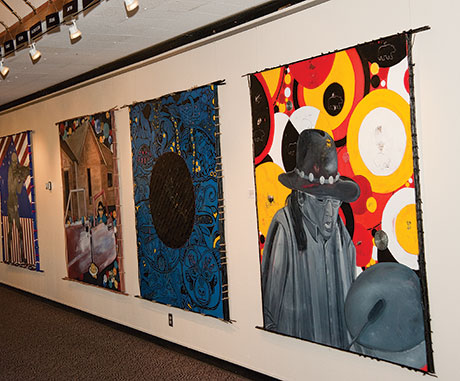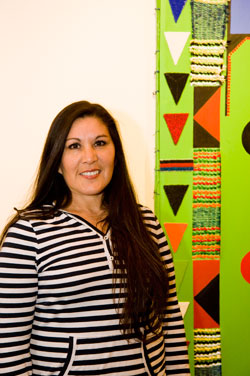
Photo by Mick Eagleson/The Advocate
Rochelle Kulei has eight pieces hanging in the Fireplace Gallery. The pieces will be on display until Nov. 27.
Between two worlds . . .
Rochelle Kulei explores conflicting American Indian and Western cultures
The Advocate
As an art student five years ago, Rochelle Kulei realized something about herself. She is naturally slow-paced and yet lives in the city, which is very fast.
She is a Shoshone Indian living in a dominant culture’s world, two very different ways of living and being.
Her mother’s generation lived in a time of forced acclimation to the white man’s way of life. This included painful experiences of prejudice, inner and outer conflicts, and the humiliation of having to denounce one’s Indian heritage. As a result, Kulei’s mother chose to not teach the Indian culture to her child. However, as a teenager, Kulei became interested in her Indian ancestry.
|
|||
She turned to her great-aunts and great-uncles to learn about her culture.
She said her inspiration comes from her native heritage, her family, and the beliefs in the culture of the Shoshone people. In an artist statement, Kulei said, “My ancestors’ stories and the experience they faced throughout their lives has made an impact in my personal life. Through my art, I hope to instill a piece of solitude in the audience’s mind of urban Natives and non-natives and hopefully they will want to change their lives by simply slowing down. I want them to feel the connection with their own souls and by doing so also be more mindful of others.”
Kulei, a recent graduate of Marylhurst University, felt comfortable as a sculptor and decided to try a different art medium for her bachelor of fine arts thesis project. Out of this challenge came the creation of “Native Symbols,” her exhibit now showing at the Mt. Hood Community College Fireplace gallery.
Asked why her pieces were so large, she said, “Because I was switching from sculpture to painting, I wanted to still feel like I was doing sculpture, so that meant that I felt like I had to make bigger images.”
There is a symbiotic relationship between the stories of her ancestors and her artwork. Kulei said, “When I am in front of a canvas I feel, I am inspired, I feel their presence. In the native languages there are no tenses for present, past or future. In America we talk about the dead as they once lived. The native people look at ancestors as living today, tomorrow and in the future.”
Asked for an example of this, Kulei said, “One time I was making the stretch bar, and when I took the canvas and started stretching it, all of a sudden I had this vision. I saw these women taking their deer hide and they were stretching it over their frames. I felt like this was it. This is what I needed to do.
“Maybe it is contemporary, but it feels like the same thing. I had to apply the gesso just like they had to scrape the hair off and they’d smash the deer brain onto it to soften it. That whole movement felt like I was doing the same thing and following my ancestor’s traditions. Once they finished the hide and treated it, then they started doing artwork on it, whether it would be beadwork or they painted on it also. I thought of the same idea. I am painting and weaving and creating something just like they did, except it is contemporary.”
Kulei has also created a unique style of framing her paintings. Instead of using common fine art frames, she uses sticks from tree branches. “Tree branches were traditionally woven together and used to build homes, or to make bed mats,” she said. “I did some weaving around the branches and then nailed them onto the stretch bar for the canvas. I thought it worked perfectly.”
In addition to her own art projects, Kulei has been the Native American education program director for the Evergreen School District in Washington for approximately the past five years, through the federally funded Title 7 program. She teaches classes for children K-12 in bead-working, moccasin-making, basket-weaving, drum-making, singing, dancing and regalia-making.
Kulei said, “I want to be out there and I want to influence. I want to help the youth. My main focus is the youth, to help them discover the power they have within and who they are and be proud of that, to take that power and do something and change our past. Change the genetics of poverty and being quiet and staying back there and not saying anything. Let’s stand up and be heard. I think that we can make a difference. It’s a lot of work; there is so much to do. I wanted to be involved somehow and what could I do? Then it all came to me. I happened to be there at the right time, got involved and started studying everyone else’s culture besides my own. I thought about the United States and all the reservations and how I could help others.”
Prior to painting, Kulei was doing art installations, which are temporary set-ups for two-to-four weeks at a time. “It is about making a statement and getting people to think about things”, said Kulei.
Kulei lives and stays balanced in two very different worlds. “That is one thing I love about Native American artists. It is not just for ourselves. One successful Native American artist means a lot to everybody. We represent everyone and we are happy and proud. We support each other in our success.
When one is successful we help them and support them because we feel they are representing us. There is no envy. We are so happy that someone is speaking for us.”
![]()
The Advocate reserves the right to not publish comments based on their appropriateness.
![]()
Notice: Undefined variable: c5t_output in /hermes/walnacweb06/walnacweb06ac/b2874/moo.advocateonlinenet1/mhccadvocate/110509/AE_NativeAmericans.php on line 233
![]()

